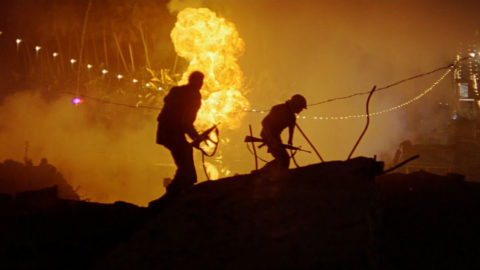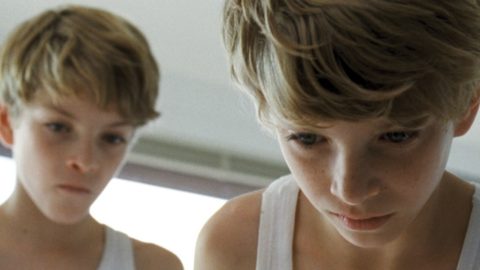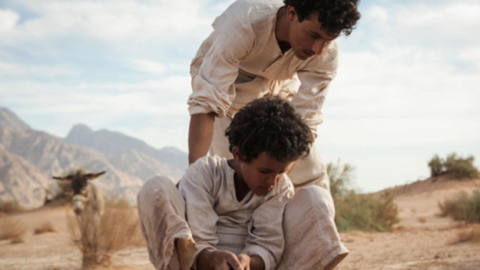Interview: Wolfgang Thaler
This interview is part of a series with influential cinematographers who attended the 2016 Camerimage International Film Festival of the Art of Cinematography in Bydgoszcz, Poland, in November.
Known for his contributions to the cinemas of Ulrich Seidl and Michael Glawogger, Austrian cinematographer Wolfgang Thaler is dedicated to unveiling the human soul through his lyrical and sensitive camerawork. With Glawogger, his departed comrade in arms, Thaler has traveled the world, crafting magnetic, pioneering documentaries that explore the struggles of the underprivileged in developing countries. Driven by ravishing, kinetic visuals, Glawogger’s films are inextricable from the places they depict, be it the simultaneously horrific and spellbinding Nigerian open-air slaughterhouse in Workingman’s Death (2006)—an engrossing look at 21st-century examples of manual labor—or the narrow, fluorescent-lit corridors of a brothel in Bangladesh, which hosts the second act of one of the most striking cinematic representations of prostitution, Whores’ Glory (2011). In Ulrich Seidl’s films—biting, anthropologically minded studies of middle-class malaise—Thaler’s measured yet equally sensuous cinematography unfolds in bare, minimalistic interiors, which wrap around the characters and serve as canvases for their obsessive emotions. Jordanian filmmaker Naji Abu Nowar’s debut feature Theeb (2014), the Western-like story of a Bedouin boy’s coming-of-age amid the turmoil of World War I, situates itself in the lineage of Thaler’s work with Seidl and Glawogger through its blending of documentary and fiction practices.
At the 2016 Camerimage Film Festival, Film Comment spoke with Thaler about his delicate process of identifying with those in front and behind the camera.
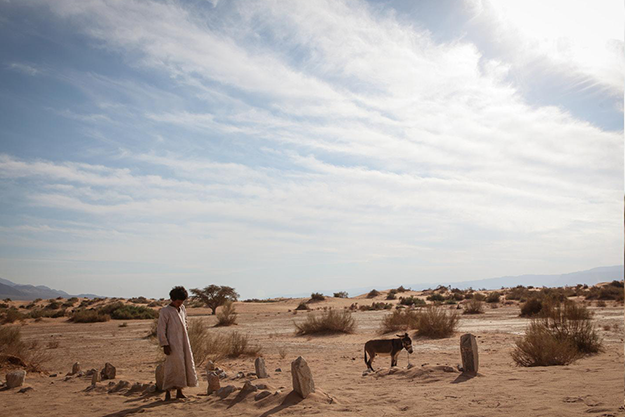
Theeb
When I interviewed Naji Abu Nowar about Theeb last year, he mentioned that you were one of the Bedouin cast’s favorite crew members and that they would always ask about you when he’d see them.
I did a film about rock climbing once, and the rock climbers didn’t believe that I could follow their lead. I left my camera and said to the guys: “Take me up there, where’s the starting point? Let’s go.” And after 50 minutes of climbing together, one of them said: “Hello, if you fall down, you’re dead.” And I said: “Yes, I know.” This was very necessary: to break their view that someone who is not a rock climber cannot do a great film about rock climbing. And it was the same with the Bedouins: they just felt that I loved the desert and their lifestyle. When I’m shooting a film, I’m the closest person to all the actors and everyone in front of the camera. And my philosophy is to create an emotional bond with them so that they can, on a very human level, open up in front of the camera and bring out their soul—this is necessary to act authentically.
You probably went through similar experiences on Michael Glawogger’s films. On Whores’ Glory [2011], you had to make the prostitutes relate to you and inspire the kind of trust that allowed them to live out their most intimate moments in front of your camera.
You know, to show all those women who I am, I had to give them a chance to watch me. For example in Bangladesh, during the first days of shooting, they just laughed at me. I was following them down corridors like an idiot with a camera. But after two days, they got used to me. And every morning when we entered their area, I walked around, making contact with the women and having long exchanges with them. This was necessary to gain their trust, because I couldn’t just be there, look through the camera, and do whatever I wanted. But the most difficult part of the shoot was Mexico.
Because the women were suspicious of you at first?
Yeah. And I couldn’t turn things around, because I had decided: “Okay. Don’t invest the same amount of emotional energy here as in Bangladesh.” So what happened is that we didn’t get anything. So after four, five days, I changed my mind, drank tequila with them and again went around every day, trying to make contact. But I didn’t get anything back. So during the last two days of the shoot in Mexico, I went through the same routine but this time I didn’t say “Hello” or anything. What happened instead is that they said “Hello” to me. So you always have to invest emotions.
We’ve been talking about getting on the same wavelength and entering into symbiosis with the people in front of the camera, but I assume the same was true of your relationship with Michael Glawogger, your closest collaborator. You two were probably past the point of verbal communication. Did you have some sort of sign language when you were working together?
I knew Michael for a very long time and I knew what he was expecting from my camerawork and what he likes to have in his films. So we didn’t really have to talk… And as far as nonverbal communication goes, there’s one scene in Bangladesh, for example, when a young man wants to buy a girl to marry her. We of course didn’t speak the language, so I had to read through the camera what was going on. I had to read the body language to know, “Okay, now is the right moment to pan to the girl and her mother,” and catch the next very important moment. I try to pick up on things and understand when there’s an emotional moment I’m not supposed to miss.
When you were alternating between working with Michael Glawogger and Ulrich Seidl, how did you handle the shift from Glawogger’s raw and immersive, in-the-moment filmmaking style, to Seidl’s stripped-down and meticulously composed, sometimes cold aesthetic?
When I started working with Seidl, it took me a while to figure out what he expected from the camerawork. His approach is all about taking everything out of the frame. So you need a very clear and empty picture to make that work. When he does his famous tableaux shots, everything must be perfect and correct, because the audience has to watch them for minutes. And if the image isn’t good enough, they simply get bored. So I always have to create an image that is neat and legible for the audience’s eyes.
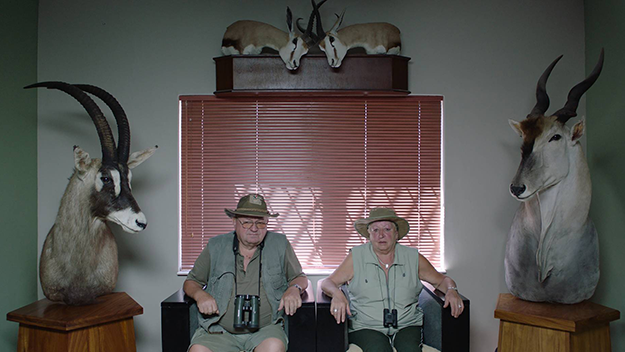
Safari
So when you are setting up a shot, you have thousands of receptors on you that are alert to every element of the frame.
Yeah. In Seidl’s fiction films, we always try to achieve an authentic style because he uses a lot of non-actors. In those cases, I’m completely free because I don’t really know what’s going on. There isn’t really a script and there are no written lines. So when a scene is taking place, I only know things like, “Okay, we are doing a scene with three actors.”
You don’t even know the dramatic situation?
No. Because what he does is work with one actor, instructing him separately from the other actors. So all the actors may have completely different information, which Seidl doesn’t tell me. He just says: “Make it editable. Do something that I can cut together and that allows me to shorten the scene if I want to.” So most of the time I have no idea what’s going on. Working this way is a challenge and I love it very much.
Your camerawork in Workingman’s Death [2005] is tormentingly beautiful. When you are following the sulfur collectors around the volcano in the Indonesia section, it’s like your camera is possessed: it seems to be everywhere at the same time, with an almost Vertovian disregard for the limitations of space and time. I know that you spent a week shooting there and Glawogger asked the workers to wear the same outfit every day for the sake of continuity. Can you talk about how you approached the filming of that sequence?
I get my inspiration from the location and the people. The sequence you’re talking about was more or less easy for me. The hardest part was sleeping outside at 2,000 meters altitude in freezing temperatures, and having to climb up 1,000 meters further every morning to then go down the same road. Breathing poisonous gas was also terrible, and we always had pure red eyes because of it. For the walking, we used a Steadicam, which we normally don’t use. But in this case it was very important, because the baskets that the workers were carrying always whipped up and down—they couldn’t have managed that kind of heavy weight otherwise. And if we were to use a handheld camera in this rough area, we wouldn’t have been able to capture the rhythm of the baskets.
How did you become aware of that?
This was decided beforehand. I told Michael: “Go to Indonesia and have a look at the volcano.” We saw the footage that a French crew had filmed there a few years earlier, and we realized that when it’s shot with a handheld camera, you don’t see what the work is about. So then the idea came about to use a Steadicam to capture that subtle motion.
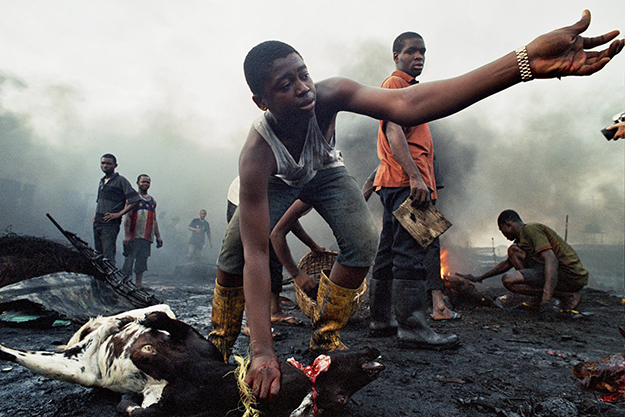
Workingman’s Death
Were you always involved in the research and location scouting on Glawogger’s films?
No, unfortunately not. That would have been a luxury. Usually, I’d come in and he’d give us at least one day to adjust to our surroundings. So most of the time we’d arrive, unload the equipment, and get ready to shoot. But this is okay by me, to be fresh and thrown into a situation. I like it. If I know what a film is about and how to shoot it, I like to decide things very spontaneously on the set, in the situation. We run a rehearsal with the actors, and then I know exactly where to place the camera and what kind of lens we need to get the scene done. Other people work in completely different ways—they need storyboards and a more elaborate preparation. My prep work is mainly to get to know the director well enough that I can catch his intentions and feelings; how he likes to tell the story. You know, if we talk about the color green, you may have a completely different perception of green than I do. But we think we’re talking about the same color. So to get in sync is the difficult part.
Because you mentioned colors, can you talk about the visual design and the philosophy behind the color scheme of Seidl’s Paradise trilogy? Each installment features a distinct, morphing palette that visually outlines the protagonist’s emotional journey.
You do that by instinct. You immediately know which color is right and which one is not. With Seidl, the preparation work is very important. For example, take the hotel room in Paradise: Love [2012]. The interior design is a mash-up of two different hotel rooms we came upon in our research. The leopard you see behind the bed comes from a town one kilometer away—we chose it because it fits the scene. So the prep work is very important concerning color, props, and set design. There weren’t many shooting days on Paradise: Love, but we spent two months preparing.
Going back to Glawogger’s films, there’s a wacky, magical moment in the Indonesia section that doesn’t leave my mind: a group of tourists are having their picture taken and suddenly sulfur collectors run past the camera and block them out. It’s like the shot of street dogs mating in Whore’s Glory—it’s so unexpected and outrageous that one is inclined to think it’s fiction.
Yeah, the scene with the dogs happened by chance. And when you see something like that, you immediately have to grab the opportunity. The situation with the tourists—there were many of them so Michael arranged the scene. We asked: “Please stay here. And, you, take the picture.”
So he staged it?
He did, but the tourists were there by chance.
What about the magnificent portrait shots of subjects staring into the lens in Glawogger’s documentaries—did you come up with that motif together?
You know, Michael and Seidl studied together and were working together before I even came into the picture. So maybe this is something that comes from their collaboration. Maybe this arose from Michael not wanting to do tableaux shots like Seidl, and he came up with this image instead. Maybe he realized that if people look directly into the lens, it engages the audience emotionally.
It does, and on Workingman’s Death, the introduction of those static shots creates a very exciting visual tension with the frenetic energy of a constantly moving camera. There’s a similar kind of discrepancy in a film like Seidl’s Dog Days [2001], which starts with these nervous, roving handheld shots and resumes with a series of obsessively composed tableaux shots when we get to the suburbs—it’s a very unsettling stylistic transition that obviously serves a thematic purpose. That rough camerawork almost completely disappeared from Seidl’s films later on… If I’m not mistaken, there are maybe two or three handheld shots in Paradise: Faith [2012]: the mise en scène feels very frozen overall. Did you want to convey the character’s disconnection from herself and her surroundings?
No… Sometimes we make the mistake with Seidl of choosing a location where we can shoot so many strong images that we forget that the film also needs some motion to come alive. It took one year to get that house [for Paradise: Faith] ready. Seidl rented the house for the whole year, which is crazy for a production company. And step-by-step, we got the interior right. I also remember how long it took them to figure out the woman’s hairstyle. They tried everything and it ended up with what you see. The best thing about this process was that the producer called from Germany and wanted to replace me—he was thinking: “If I had this other cameraman, he just needs to go and push a button. We don’t need lights or preparation work. We can do it for very cheap.” But they don’t realize that everything is staged very precisely. They think it’s all “real,” but it’s a fiction.
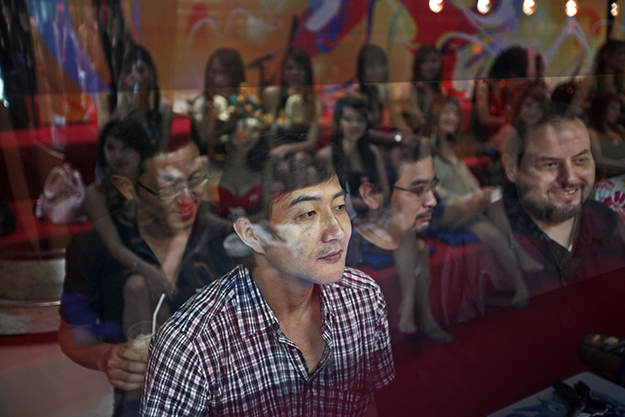
Whores’ Glory
Actually every shot in that film resembles a Caspar David Friedrich painting.
Even the light is not there by chance. There’s a reason for everything.
I assume you didn’t do the same amount of lighting work on Glawogger’s films because you couldn’t always intervene technically.
You know, when you’re working in those kinds of situations, you can’t afford to bring lights—it’s impossible. And if you’re in locations like the brothels, you cannot bring in any lights. You have to be very careful not to alter the locations too much.
So you just added onto the available light when needed?
In Mexico, it took two electricians three days to illuminate the place. You couldn’t just go there and shoot because there wasn’t enough light. When I go to a new country, I look out for the light situation there. For example in Bangladesh, they have this very blue fluorescent light and these dirty old weak bulbs. So I was using the mixture of this blue, and yellow or red light to get the contrast. You can only rely on this technique when you have people in front of the camera who don’t have a white skin tone. On a white skin tone, it would be a failure, but it works very well on dark skin. Every location has a different texture and you use that to light the picture.
I’ve read that you’re also a farmer and have made films about bees…
My first profession was beekeeping. To make a long story short, I was growing up in a village and if you have bees, nobody goes there because everybody is scared of bees. And my grandfather had bees.
So it was in the family?
It was in the family somehow, and that was the reason for me being a beekeeper. And with the bee film, I just wanted to explore microphotography.
And from beekeeper how did you switch to being a cinematographer, if I may ask?
It was quite clear to me when I was 15 that I wanted to go into cinema. When I heard music, I always saw images in my head. So I had to deal with this because I couldn’t describe my images to other people, and you always like to communicate what you think.
Your inner world.
Yes. So I decided when I was 22 to go to the Film Academy Vienna and bought a photo camera with the last money I had.
That’s where you met Seidl and Glawogger?
Yeah. And we collaborated together from then on.
Yonca Talu is a filmmaker living in New York. She grew up in Istanbul and recently graduated from NYU Tisch.



